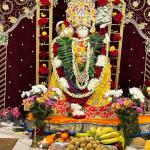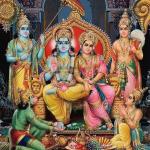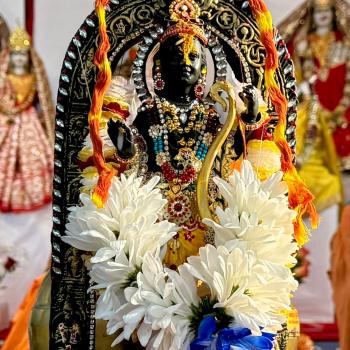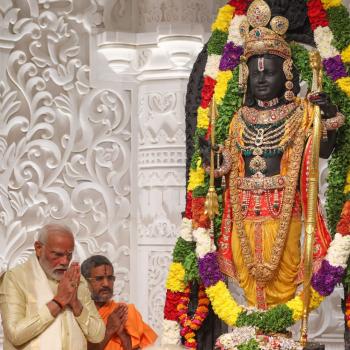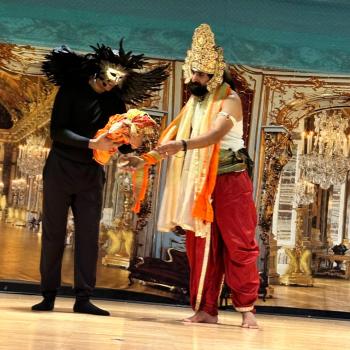The focus here is on Hanuman’s diplomacy with the ability to disguise. It combines his communication and collaboration skills, and composure. He could analyze the situation, think critically, and make himself aware of his surroundings. His calm personality, unless provoked, is another trait of his diplomacy.
Part II will cover Hanuman’s defiant diplomacy when provoked by King Ravana in Lanka.
A brief introduction to the Hindu God Hanuman was offered recently Hanuman, the prominent character in the Hindu epic Ramayana, illustrates the life of Lord Ram, the seventh incarnation of Lord Vishnu. Hanuman is a fine example of loyalty and devotion to his Master Ram.
Caption: A still from the popular TV serial Ramayana showing Lord Ram and Sugriva in the middle. On the left are Hanuman and Lakshman and other courtiers of Sugriva are on the right. This is the scene in Kishkindha when Ram and Lakshman meet Sugriva and ask for his assistance in searching for Sita. (Source: https://www.republicworld.com/entertainment-news/television-news/arun-govil-reveals-that-after-ramayan-his-career-was-over.html)
Caption: Lord Ram and Sugriva are in the middle with Hanuman and Lakshman on the left. The scene is from the popular Ramayan serial on Indian TV. It is adapted from https://www.republicworld.com/entertainment-news/television-news/arun-govil-reveals-that-after-ramayan-his-career-was-over.html
Diplomat Hanuman: We cover Hanuman’s excellence in diplomacy from Kishkindha-kand of Ramayana (brokering the friendship between Ram and Sugriva). Hanuman is humble and diplomatic when he meets with Ram and Lakshman in disguise.
Part II will discuss Hanuman’s diplomacy rooted in the Sunder-kand (Ravan’s court in Lanka).
Hanuman meets Ram: Diplomacy in Disguise
Hanuman meets Ram and his brother Lakshman in disguise as they were wandering in the mountainous region of Rishyamukas in Kishkindha (present-day State of Andhra Pradesh). The mountain was home to Sugriva and his Ministers including Hanuman. Sugriva, shunned by his older brother (Bali), felt safe in the caves. Why? Because Bali was forbidden to come there or face death.
Sugriva got scared when he saw two strangers in the region. They were dressed like hermits but with ‘Dhanush-ban’ (bow and arrows) on their shoulders. He wondered if Bali sent them for avenge and other mysterious reasons. Sugriva was very anxious to know the motives of the strangers.
Sugriva knew Hanuman’s innate capabilities of diplomacy and loyalty, and ability to disguise. So he asked Hanuman to disguise himself as an innocent-looking Brahmin and find out who and why they were there.
Hanuman, a sharp diplomat with composure, assessed the situation and surroundings. He observed that both of them had charming prince-like personalities with the brilliance of a warrior. Accordingly, Hanuman approached the two strangers and politely inquired if they were Nara (ordinary man) or Narayana (another name for Lord Vishnu).
Ram introducing himself: Lord Ram introduced himself and Lakshman as the sons of King Dashrath of Ayodhya ( in the State of Uttar Pradesh where Ram was born). They were there as part of their 14-year exile from Ayodhya. Ram told Hanuman that he was searching for his wife, Sita, who was kidnapped.
Sita Jayanti: Incidentally, April 29 is also Sita Jayanti, a lesser-known fact to many practicing Hindus like this author.
Hanuman introducing himself: Ram asked Hanuman to introduce himself. By then, the wise Hanuman had recognized his long-lost Lord Ram. Thereafter, he felt comfortable, came out of his disguise, apologized, and kneeled on Lord Ram’s feet. Ram embraced Hanuman as if they were long-lost friends. Hanuman was now at peace and without fear. Lord Ram also recognized his loyal devotee, Hanuman.
During the conversation, Hanuman sensed deep grief and sadness on Ram’s face. He explained to Ram who Sugriva was and why he hid in the cave. Sugriva’s older brother, Bali, had unjustifiably exiled him. Hanuman, Sugriva’s close confidant, contemplated that Sugriva should be happy to help Ram in search for Sita with his army of vanaras (ordinarily called monkeys).
Vanaras: Hanuman is generally quoted as a Monkey God but a reader of the earlier article introduced me to a short video. It describes Hanuman, Sugriva, and their army belonging to a different race altogether (Vanaras). They are physically strong and intelligent. It is an exciting concept requiring additional research and possibly a topic in the future.
Dealmaking with Diplomacy and Tact
Hanuman became confident that Ram and Lakshman, Ayodhya’s princes in exile, had no other motive but genuinely looking for assistance in locating Sita. He unhesitatingly took them to the cave and introduced them to Sugriva and his ministers. Sugriva extended a warm welcome to Lord Ram and his brother. Over time, Ram, Sugriva, and Hanuman became trusted friends and their relationship grew stronger.
Diplomacy is generally based on good faith promises which are mutually beneficial. In the present context, Hanuman, a diplomat par excellence, suggested that Lord Ram should help Sugriva to be free of Bali’s threats and regain his lost kingdom. In exchange, Hanuman asked Sugriva to extend help to search for Sita.
Thus, Hanuman used his skills in brokering a mutually beneficial “deal” without making it sound like a business transaction. Accordingly, Ram, with the help and advice of Sugriva and Hanuman, killed Bali enabling Sugriva to regain freedom and kingdom from his brother.
Sugriva crowned: As the ruler of Kishkindha, Sugriva became immersed in his administrative and family affairs. He forgot fulfilling his promise to help search Sita which angered Ram. Hanuman sensed it and intervened. He advised Sugriva to seek Ram’s forgiveness for the delay. Sugriva immediately complied and met Lord Ram reassuring him to do everything to search for Sita. Thus, Hanuman diffused the situation tactfully with his communication skills.
Hanuman vows to help: Sugriva knew that Hanuman is the only person with all the skills to help in the search for Sita. When Sugriva asked Hanuman, the latter willingly accepted the challenge to serve his Lord. At that time, Ram told Sugriva and Hanuman about a meeting with Jatayu (a mythical bird) on his way to the mountains. Jatayu, an old friend of King Dashrath, unsuccessfully tried to rescue Sita from the clutches of Ravana while he was taking her to Lanka. The first task was for Hanuman to travel to Lanka looking for Sita.
The next part will discuss Hanuman’s travel to Lanka, locating Sita in captivity, and earning her trust with his excellent communication skills. We also discuss a plan hatched by Hanuman to meet with King Ravana as Ram’s envoy. When provoked, Hanuman reacted diplomatically but defiantly in Ravana’s court.



